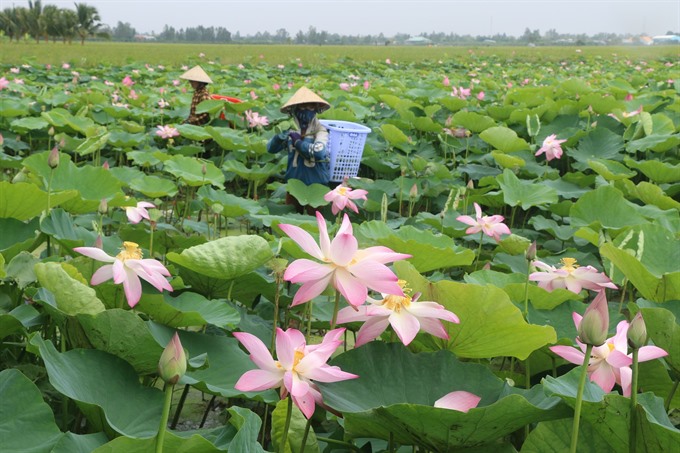 Society
Society

Farmers in the Mekong Delta province of Đồng Tháp have begun to use more than 3,000ha of low-yield rice fields for growing fruits and other crops this year.
 |
| Farmers harvest lotus seeds in Đồng Tháp Province’s Thanh Bình District. — VNA/VNS Photo Nguyễn Văn Trí |
ĐỒNG THÁP — Farmers in the Mekong Delta province of Đồng Tháp have begun to use more than 3,000ha of low-yield rice fields for growing fruits and other crops this year.
They are growing mostly corn, sesame, soybean, sweet potato, lotus, mango, longan, orange and dragon fruit, and their incomes have doubled or even tripled, according to local authorities.
Those growing corn have average yields of 8-12 tonnes per hectare per crop and each time earn VNĐ7-10 million (US$300-430) higher than from rice.
Provincial authorities have encouraged farmers to use infertile paddies to grow corn and establish concentrated areas for the crop.
The province has zoned such concentrated corn areas in Hồng Ngự, Thanh Bình, Tam Nông, Lấp Vò and Lai Vung districts.
In the 2018-19 winter-spring crop, the province offered rice farmers a subsidy of VNĐ3 million ($130) per hectare for buying corn seeds for planting if they switched, according to Nguyễn Thành Tài, deputy director of the local Department of Agriculture and Rural Development.
The province encourages farmers to grow corn varieties that have shorter maturity periods, high quality and consistent yields, including hybrid varieties.
It has also identified high-yield sesame varieties VV12 and VĐ3 as suitable for growing in drought-prone areas in Cao Lãnh City and the districts of Cao Lãnh, Lấp Vò and Tân Hồng.
Many farmers rotate rice and sesame on their rice fields, growing rice in winter-spring and summer-autumn and sesame in spring-summer.
The sesame crop helps improve the soil’s fertility and saves water, especially in the dry season. Besides, it earns them more than VNĐ30 million ($1,300) per hectare per crop, VNĐ5-10 million ($215-430) more than summer-autumn rice, according to farmers.
Many rice farmers who have switched to fruits in recent years earn higher incomes since fruits have high value and demand.
Ngô Văn Bình, who has turned his 7,000sq.m rice field in Lai Vung District’s Vĩnh Thới Commune into a red-flesh dragon fruit orchard, said he now earns around VNĐ200 million ($8,620) a year.
“Planting dragon fruit requires high initial investment, but the fruit is easy to grow and has high yields so farmers can recover the investment quickly, while earning good incomes.”
His fruits have a guaranteed buyer in the form of a company, he said.
In Lai Vung, other crops have been grown on more than 2,600ha of rice paddies since 2016, according to its Agriculture and Rural Development Division.
But the small scale of farming, scattered locations of farms, uneven farming skills and lack of regular outlets are obstacles to restructuring, the division said.
Mai Quốc Hậu, head of the division, said: “The district will have detailed plans for converting low-yield rice fields in each area and for their markets.”
The district would work with companies to guarantee outlets for farmers, he promised.
The district also plans to teach farming techniques and provide a subsidy of VNĐ60 million ($2,580) to each co-operative team and co-operative registering for the first time to grow crops to Vietnamese good agricultural practice (VietGAP) standards. — VNS




